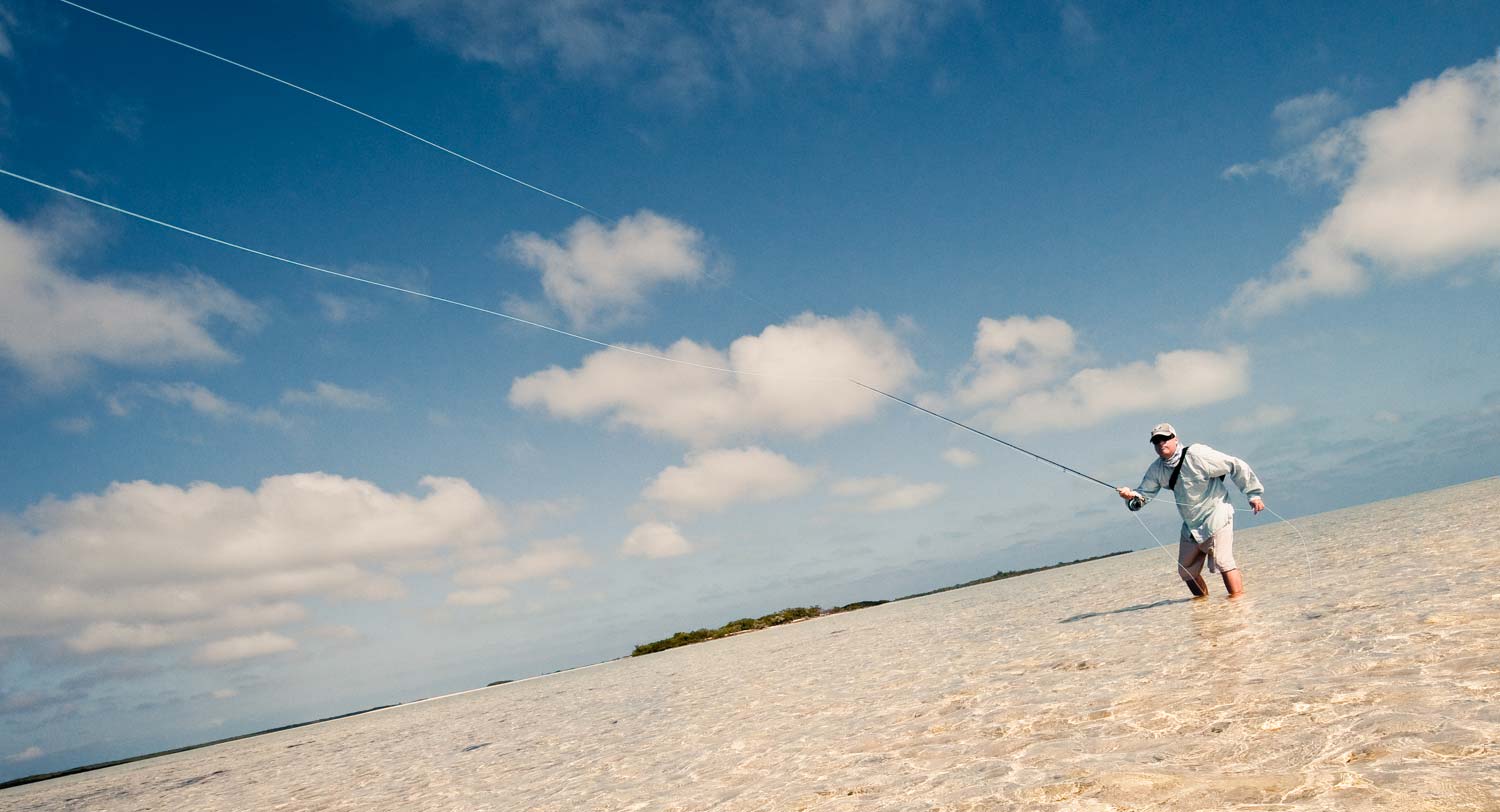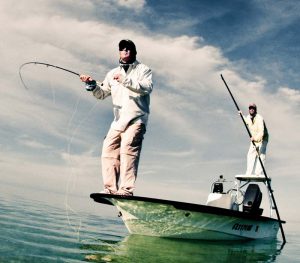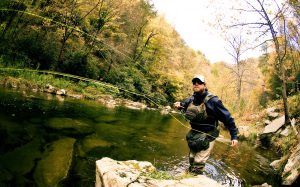
Photos by Louis Cahill
By Louis Cahill
A powerful fly cast is about technique and timing, not power and speed.
That statement is often repeated, and it reminds me of something we used to say in martial arts. “Size and strength don’t matter…unless the other guy is bigger and stronger than you.”
In my experience, there isn’t one answer for every angler. Some folks use too much power and not enough technique, and others seem afraid of the rod and lack any kind of physicality. It does not take a lot of physical strength to make a good fly cast, but it is an athletic endeavor and requires a degree of physical prowess, or at least confidence.
I like the comparison of the casting stroke and using a hammer. I like it because it explains the smooth application of power and the abrupt stop, but also because it captures the idea of the appropriate use of power. You don’t pick away at a nail as if you had all day to drive it home. You also don’t wail away as hard as you can swing, hitting everything in arm’s reach. You use the right amount of power for the job. A gentle tap for a tack (read 3 weight), and a manly swing for a spike (12 weight).
That said, technique always trumps power, and the skilled caster blends the two to make tight energized loops and control his line to make the best presentation.
Bend the rod
 The most fundamental part of making a fly cast is loading the rod. Put very simply, loading the rod is putting a bend in it. The action of a bent rod straightening is what casts the line, not the motion of your arm. It’s much more like shooting a slingshot that throwing a baseball.
The most fundamental part of making a fly cast is loading the rod. Put very simply, loading the rod is putting a bend in it. The action of a bent rod straightening is what casts the line, not the motion of your arm. It’s much more like shooting a slingshot that throwing a baseball.
When I’m working with an angler who is struggling to load their rod, I like to have them hold the rod in front of them with two hands, one hand on the grip and the other near the stripping guide. Then I ask them to bend the rod. The natural reaction is to put their thumbs on the shaft and press away.
That’s exactly what should be happening when you cast. The only difference is that the hand near the stripping guide is replaced by the weight of the line. The thumb presses forward in a straight line, like driving a thumbtack into the wall. When the bent rod stops, the recoil of the rod sends the line like the rubber bands of the slingshot.
Accelerate the stroke
If you ever feel like you should be casting “harder,” too little acceleration is likely your problem. I see a lot of anglers who get no power in their cast because their casting stroke is all the same speed. To continue to load a rod throughout the casting stroke, there must be a smooth acceleration. It doesn’t matter how fast, or slow, the stroke is, if there is no acceleration, there is no load.
There’s an exercise I find helpful for this. I’ll ask the angler to false cast about thirty feet of line, making as tight and smooth a loop as possible. I’ll have them slow their casting stroke down as much as possible, while keeping the loop tight and energized. Slowing down lets you really study your timing. You can cast a tight loop surprisingly slow, but only if that acceleration is really smooth.
Stop the rod
 Without a stop, there’s no loop, and the harder the stop, the more energy goes into the loop. Think back to that slingshot analogy. If you held onto your rock and let the bands down easy, it wouldn’t go very far. The fly rod works the same way. Just like you want a nice clean release on the slingshot, you want a good hard stop on your casting stroke. High and hard, I always say, and when you make your presentation, keep the rod in the stop position until the fly line straightens out. Just as the loop reaches the leader is the best time to drop your rod. There are special exceptions to the stop and hold, but for a powerful cast that’s the best method.
Without a stop, there’s no loop, and the harder the stop, the more energy goes into the loop. Think back to that slingshot analogy. If you held onto your rock and let the bands down easy, it wouldn’t go very far. The fly rod works the same way. Just like you want a nice clean release on the slingshot, you want a good hard stop on your casting stroke. High and hard, I always say, and when you make your presentation, keep the rod in the stop position until the fly line straightens out. Just as the loop reaches the leader is the best time to drop your rod. There are special exceptions to the stop and hold, but for a powerful cast that’s the best method.
Wait for it
One of the most important, and most overlooked, parts of the fly cast is the pause. The pause, which comes after the stop on both the forward and backcast, allows the fly line to straighten out in the air. If you don’t wait for the line to straighten, all kinds of things go wrong, but most critically you can’t load the rod.
The timing of this pause is very precise. It has to be instinctive. That is to say, you need to practice this until you don’t think about it any more. The line should straighten out, but not dip off of its straight line course. If the line is still looped over itself when you start your stroke, you’re too early. If it dips and loses energy, you’re too late.
The exercise I talked about earlier where you false cast and make loops as slow as possible is a great way to dial this in. Once you master making perfect slow loops, speed them up gradually until you are casting as fast as you can without tailing your loop. If you tail a loop, slow down and start over. Here’s a good video.
Flatten the stroke
The best way to put power into your cast is to tighten your loops. The only way to do that is by keeping your rod tip traveling in a straight line. An arched casting stroke will make a big loop that doesn’t transfer energy efficiently. A nice flat casting stroke will make a tight energized loop that will cut the wind and deliver the fly on target.
Check out this video! This is the best way I know to learn how to make tight loops.
Keep it smooth
Your casting stroke should be smooth as butter, regardless of the speed of the stroke. Any herky-jerky stuff going on in your stroke will introduce slack and slack kills the transfer of energy. Watch any great caster, Pete Kutzer comes to mind, and you’ll notice how effortless their casting stroke seems. That’s because it’s smooth. Smooth is efficient and efficient is powerful.
So much great stuff in this video of Pete’s.
Power the backcast
It’s impossible to make a good forward cast without first making a good backcast. Your casting stroke should be symmetrical. The same nice energized loop in the back as in the front. That’s often not the case. If your backcast is anemic, here are a couple of things to try.
Be sure your backcast is traveling in a straight line and has a nice hard stop. This is a common problem. Moving your index finger forward on the grip will give you a little extra leverage in your backcast. I like Joan Wulff’s backcast exercise. Hold a broom out in front of you, with the same grip you hold your rod, and lift it using just your wrist. That will help develop the muscles used in the backcast. Make sure your haul is working on the backcast too. If there is a problem with your double haul, that’s where it will show up.
Emphasis the haul
If you are casting into a strong wind, and feel like you need extra power in your cast, the haul is where you’ll find it. Your instinct may tell you to add the power with your rod hand, but that’s a recipe for disaster. Keep the same stroke, and timing you’ve practiced until it’s in your muscle memory. Put the extra power in your haul and watch the line go!
Tune your setup
 Great timing and technique are the secret to a powerful cast, but great timing and technique are a whole lot easier when your rod is set up properly. That means the right line, leader and a well-balanced reel. Choosing a fly line to match your rod is harder than it should be. There are too many options and virtually no agreement on standard weights. There’s no point in complaining about it. It is what it is.
Great timing and technique are the secret to a powerful cast, but great timing and technique are a whole lot easier when your rod is set up properly. That means the right line, leader and a well-balanced reel. Choosing a fly line to match your rod is harder than it should be. There are too many options and virtually no agreement on standard weights. There’s no point in complaining about it. It is what it is.
The best advice I can give you is to talk to the folks at your local shop, and if at all possible, try the line on your rod before you buy it. Even if it casts perfectly for the shop guy, it may not for you. If you have a really fast rod, you may need an overweighted line and even a more aggressive head. If you have a slower rod, a longer belly and truer weight may be best. Past that, I’m afraid its trial and error.
Once you’ve settled on a line, be sure to match an appropriate leader to that line. The same leader that works on your 4 weight is not going to work on an 8 weight. You want to try and match the size and stiffness of the butt section of the leader to the tip of the fly line. It’s always best to tie your own. Click here for a deep dive on that topic. https://www.ginkandgasoline.com/fly-fishing-tips-technique/understanding-leaders-means-better-fly-fishing/
Ok, that was a major download of casting info.
Bookmark this article. If you made it through, you’re a rockstar and on your way to casting like one. This is, however, too much information to actually implement all at once. If it’s of interest to you, I’d recommend that you bookmark this article and work on a section at a time. Go out to the yard or the park with it up on your phone and practice one of these tips at a time. That’s the best way to turn the information into technique. I hope it helps you get the power you want out of your fly cast.
Louis Cahill Gink & Gasoline www.ginkandgasoline.com hookups@ginkandgasoline.com Sign Up For Our Weekly Newsletter!
Superb instruction!! Yes, already bookmarked! Covers all the basics. A friend and I watch/video each other. Sometimes small faults creep in (no pun intended) that the caster isn’t aware of, but are plainly evident to anyone with experience who is watching.
However, when fishing, self-diagnosis is very useful!!
Good article, one of your best. Thanks!
Excellent!
Pingback: Ten Casting Tips | MidCurrent